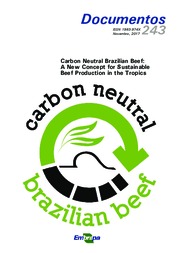Carbon Neutral Brazilian Beef: A New Concept for Sustainable Beef Production in the Tropics.
Carbon Neutral Brazilian Beef: A New Concept for Sustainable Beef Production in the Tropics.
Author(s): ALVES, F. V.; ALMEIDA, R. G. de; LAURA, V. A.
Summary: Agriculture in Brazil, as well as worldwide, has been striving to meet the increasing demand for food, timber, fibers and bioenergy. While larger production is necessary, restrictions for expansion over natural environments increase. For the Brazilian beef industry, the current trend is towards little increase on herd numbers, despite reduction on grazing areas. This will lead to intensification of sown pastures, optimizing use of inputs, along with improved management, feeding and introduction of technologies like integrated systems. There is also a growing concern from the sector towards environmental preservation and the need for a more efficient use of inputs and natural resources if future demands are to be met. Therefore, agriculture will have to play its role on sustainability, resulting in socio-economic and environmental benefits. Such expectations, especially from the international community, offer additional opportunity for the Brazilian beef chain. To add value on ex- ports, some aspects must be addressed. For instance, animal welfare, water and soil conservation, while mitigating greenhouse gases emissions (GHG). The last one through carbon sequestration can become an environmental service provided by grazing areas. Today, Brazil is able to supply such services through production systems that include a forestry component integrated to cattle ranching. For instance, Brazilian Government created in 2010 the Plano ABC (Agricultura de Baixa Emissão de Carbono), a low carbon emissions agriculture plan, stimulating implementation of integrated crop-livestock-forest systems (ICLF) as one of the strategies to mitigate GHG emissions from agriculture. The official plan ensures credit for projects adopting this technology (BRASIL, 2012). For almost three decades, Embrapa develops integrated systems for different biomes together with universities, other research institutions and the private sector. Aim is to reclaim, diversify and improve pastures management. Considering the importance of carbon fixed in such systems, the need for a brand or a trademark associated with the concept of these systems emerged, ensuring a distinct product that incorporates some of the mentioned parameters, especially related to mitigation/neutralization of GHG emissions and environmental sustainability.
Publication year: 2017
Types of publication: Booklets
Unit: Embrapa Beef Cattle
Observation
Some of Embrapa's publications are published as ePub files. To read them, use or download one of the following free software options to your computer or mobile device. Android: Google Play Books; IOS: iBooks; Windows and Linux: Calibre.
Access other publications
Access the Agricultural Research Database (BDPA) to consult Embrapa's full library collection and records.
Visit Embrapa Bookstore to purchase books and other publications sold by Embrapa.

